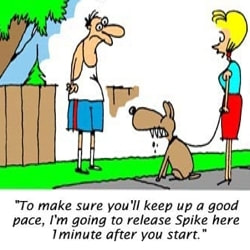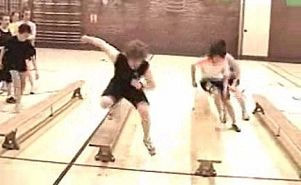Train Fast to Skate FastBy Susan Ellis, July 2010
|
The harder you work, the harder it is to surrender. ~ Vince Lombardi |

Just as skating technique has changed drastically over the years, so have the methods used to train our bodies to perform at their best. It used to be that ‘endurance training’ meant hours spent in the saddle or running long, slow distances (LSD training). And while this is still an effective method of getting in shape, it’s not really the kind of conditioning we are looking for in speed skating, especially for short track and shorter distances in long track. You will probably still find many 10K skaters doing lots of LSD training, but for the most part speed skating is about building and training more fast twitch muscle fiber than slow twitch 10K fibers. But even 10K skaters and marathon runners are using short interval training to increase performance. Former Canadian coach, Yves Nadeau told me about 20 years ago in explaining his training methods, “If you train to go slow, you will go slow.” It’s true! If you never push your body to maximum speed, how will it know how to find it in racing?
Basically LSD training is just aerobic slow training, meaning that you aren’t working very hard or breathing very hard so your body uses oxygen as its main energy source. You can keep going at a steady slow pace for a very long time. It improves the oxygen delivery system in the body by increasing capillaries and improving the heart and lung function. But we know that’s not really what happens in skating. We are breathing darn hard and our muscles are screaming. High Intensity Interval Training (HIIT) is a training method used to improve performance with short, intense sprint training sessions. It not only increases your anaerobic capacities, but also your aerobic capacities.
HIIT works both the aerobic and the anaerobic system. The anaerobic system works without oxygen and uses the energy stored in the muscles (glycogen) for short bursts of activity. The by-product, lactic acid, is that burning sensation you feel in your muscles as you go in to oxygen debt, meaning your body can’t pay back the energy used fast enough. During the recovery phase the heart and lungs work together to pay back this oxygen debt and break the lactic acid down into energy you can use again. The body adapts by forming new capillaries to increase the oxygen delivery to the working muscles, while the muscles adapt a higher tolerance for lactic acid. So, overall, you are improving both your aerobic and anaerobic systems.
One of the most popular HIIT training methods recently is called the Tabata Method. Tabata training was developed by Dr. Izumi Tabata and a team of researchers from the National Institute of Fitness and Sports in Tokyo. He also happens to be a speed skating coach. It involves doing 8 times 20 seconds of super intense exercise followed by 10 seconds rest. Seems rather short to be of any benefit doesn’t it? But in the original study conducted by Tabata, athletes using this short, high intensity method trained 4 times per week, plus another day of slow steady-state training, and obtained gains similar to a group of athletes who did only steady state (70% VO2max) training 5 times per week. The steady state group had a higher VO2max at the end (from 52 to 57 ml/kg/min), but the Tabata group had started lower and gained more overall (from 48 to 55 ml/kg/min). Also, the Tabata group gained 28% in anaerobic capacity compared to no gain in anaerobic capacity for the steady state group. The steady state group had trained a total of 30 hours compared to the Tabata group who trained only 2 hours.
A study by Gibala et al. showed that 2.5 hours of sprint interval training produced similar biochemical muscle changes to 10.5 hours of endurance training and similar endurance performance benefits.
In athletes who are already highly trained, improvements in performance become harder to achieve. Research has shown that simply increasing training volume does not necessarily lead to better performance in these athletes. However, increased training intensity can lead to improvements. A 2009 study by Driller showed an 8.2 second improvement in 2000m rowing time following 4 weeks (7 sessions) of HIIT in well-trained rowers. The interval training used by Driller and colleagues involved 8 x 2.5 minute work bouts at 90% of vVO2max, with individualized recovery intervals between each work bout.
Basically LSD training is just aerobic slow training, meaning that you aren’t working very hard or breathing very hard so your body uses oxygen as its main energy source. You can keep going at a steady slow pace for a very long time. It improves the oxygen delivery system in the body by increasing capillaries and improving the heart and lung function. But we know that’s not really what happens in skating. We are breathing darn hard and our muscles are screaming. High Intensity Interval Training (HIIT) is a training method used to improve performance with short, intense sprint training sessions. It not only increases your anaerobic capacities, but also your aerobic capacities.
HIIT works both the aerobic and the anaerobic system. The anaerobic system works without oxygen and uses the energy stored in the muscles (glycogen) for short bursts of activity. The by-product, lactic acid, is that burning sensation you feel in your muscles as you go in to oxygen debt, meaning your body can’t pay back the energy used fast enough. During the recovery phase the heart and lungs work together to pay back this oxygen debt and break the lactic acid down into energy you can use again. The body adapts by forming new capillaries to increase the oxygen delivery to the working muscles, while the muscles adapt a higher tolerance for lactic acid. So, overall, you are improving both your aerobic and anaerobic systems.
One of the most popular HIIT training methods recently is called the Tabata Method. Tabata training was developed by Dr. Izumi Tabata and a team of researchers from the National Institute of Fitness and Sports in Tokyo. He also happens to be a speed skating coach. It involves doing 8 times 20 seconds of super intense exercise followed by 10 seconds rest. Seems rather short to be of any benefit doesn’t it? But in the original study conducted by Tabata, athletes using this short, high intensity method trained 4 times per week, plus another day of slow steady-state training, and obtained gains similar to a group of athletes who did only steady state (70% VO2max) training 5 times per week. The steady state group had a higher VO2max at the end (from 52 to 57 ml/kg/min), but the Tabata group had started lower and gained more overall (from 48 to 55 ml/kg/min). Also, the Tabata group gained 28% in anaerobic capacity compared to no gain in anaerobic capacity for the steady state group. The steady state group had trained a total of 30 hours compared to the Tabata group who trained only 2 hours.
A study by Gibala et al. showed that 2.5 hours of sprint interval training produced similar biochemical muscle changes to 10.5 hours of endurance training and similar endurance performance benefits.
In athletes who are already highly trained, improvements in performance become harder to achieve. Research has shown that simply increasing training volume does not necessarily lead to better performance in these athletes. However, increased training intensity can lead to improvements. A 2009 study by Driller showed an 8.2 second improvement in 2000m rowing time following 4 weeks (7 sessions) of HIIT in well-trained rowers. The interval training used by Driller and colleagues involved 8 x 2.5 minute work bouts at 90% of vVO2max, with individualized recovery intervals between each work bout.
There is still some debate about whether a training season should start with LSD training or HIIT training. One very successful cycling club uses HIIT right from the start before introducing LSD training into the program. It makes sense as competitive cycling is a sport where a very high cadence (pedal revolutions per minute) is important. If you start out training using a slower cadence it’s harder to shift to a higher cadence because your legs are more used to turning over slowly. I guess in my opinion it depends somewhat on the base conditioning of the athlete. Totally untrained athletes will benefit from either LSD or HIIT. But a well-trained athlete with a multi-year training history may be more ready to jump in to HIIT training earlier than an untrained athlete. And that’s not to say that LSD training doesn’t have a place in the training regime. The body can only take so many days a week of HIIT so the other days could be spent on LSD training or easier recovery type programs. And technical training is just as important in speed skating as high intensity training. Technical training should be done at both lower speeds and higher speeds. But if you are doing it at higher speeds make sure to keep the intervals short and technically correct. Otherwise, it’s not really technical training is it? My motto is that if the session is really for technique, then once you can no longer hold the technique, you stop and rest. Another advantage of sport specific HIIT training is that you develop the ability to recruit and fire the same fast twitch muscle you use in skating. Going back to the cycling analogy, if a cyclist only trains at a cadence of 80 rpm and you ask that cyclist to now crank out 120 rmp, they are likely to be bouncing all over the place in the saddle because they don’t have the technique to do it that fast. They aren’t used to firing as many muscle groups as needed to smoothly go at 120 rmp.

A good way to do HIIT skating specific training early in the training season is to do it off ice using fast skating imitations like forward leaps in skating position, or skating jumps, and save the on ice training for slower technical drills and laps. You can add a little on ice speed work to it, but make sure to do it with good technique, otherwise you will have blown all the technical drills and laps you did.
Additional reading:
Tabata Training
Work Hard, Not Long – K. Barr
Lactate Threshold Training
Journal of Applied Physiology
Additional reading:
Tabata Training
Work Hard, Not Long – K. Barr
Lactate Threshold Training
Journal of Applied Physiology
